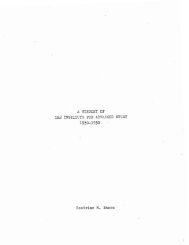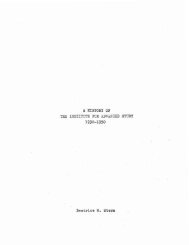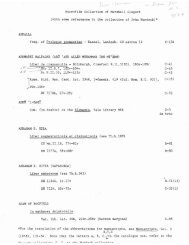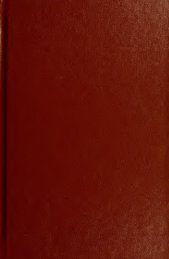First progress report on a multi-channel magnetic drum inner ...
First progress report on a multi-channel magnetic drum inner ...
First progress report on a multi-channel magnetic drum inner ...
Create successful ePaper yourself
Turn your PDF publications into a flip-book with our unique Google optimized e-Paper software.
A-2<br />
Using this formula (i.So, assuming each pole to be a line pole)<br />
let us see to vmat extent vje can approximate the shape of an experimentally<br />
deterndned voltage patterno The pattern for a single-wire head spaced 2 m.ils<br />
from the mgnetic medium is shown in Drawing C-5-2021 al<strong>on</strong>g with the corres-<br />
p<strong>on</strong>ding computed paUern. This pattern was computed as follows „ Measuring<br />
the value of y to the center of the wire we have y = 2o5 mils and hence<br />
e = k<br />
t<br />
2,$ _ 2o5<br />
(^x)^ > 6„25 W>^)^ > 6. 25 J<br />
The value of x for which e is a maximum, (minimum) <strong>on</strong> the experimental curve<br />
is X = + 1,8 mils. Setting the derivative of the above expressi<strong>on</strong> to zero<br />
at X = + 1.8 we obtain Z = 1.25 mils « The voltage pattern can then be<br />
computed. Kote that the overall length of the dipole is 2.5 rrdls, or lass<br />
than 1/4 of the extrapolated length of 10.4 milso This shows that if we<br />
space dipoles according to the extrapolated width (.see Secti<strong>on</strong> 3ol) there<br />
is a c<strong>on</strong>si derable separati<strong>on</strong> of the poles of adjacent dipoles and hence<br />
little interference between them^ This is c<strong>on</strong>sistent with the fact that<br />
our studies of dynan.ic recording showed that pulses could be safely spaced<br />
according to the extrapolated length. It should be noted in this c<strong>on</strong>nec-<br />
ti<strong>on</strong> that a dynarrically recorded dipole is l<strong>on</strong>ger than th-. corresp<strong>on</strong>ding<br />
statically recorded <strong>on</strong>e because of the moti<strong>on</strong> of the head during the<br />
recording. However, the record nulses used in the investigati<strong>on</strong> had a<br />
durati<strong>on</strong> of <strong>on</strong>ly 0.2 microsec<strong>on</strong>d which corresp<strong>on</strong>ds to a moti<strong>on</strong> of <strong>on</strong>ly<br />
0.2 mils at a peripheral velocity of 1000 iriches per sec<strong>on</strong>d.<br />
It will be noted in Drawing G~5-2021 that the calculated pattern<br />
is broader than the m.easured <strong>on</strong>e. This may seem surprising since the cal-<br />
culati<strong>on</strong>s were based <strong>on</strong> a line-dipole, whereas we would expect some spread-<br />
ing (especially at the surface — ivhcre we liave ass'<strong>on</strong>.ed the dipole to be;,<br />
" I
















